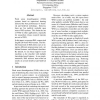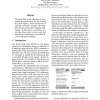ACL
2010
13 years 10 months ago
2010
In this paper, we propose a novel method for automatic segmentation of a Sanskrit string into different words. The input for our segmentizer is a Sanskrit string either encoded as...
ACL
2010
13 years 10 months ago
2010
This work models Word Sense Disambiguation (WSD) problem as a Distributed Constraint Optimization Problem (DCOP). To model WSD as a DCOP, we view information from various knowledg...
ACL
2010
13 years 10 months ago
2010
Presupposition relations between verbs are not very well covered in existing lexical semantic resources. We propose a weakly supervised algorithm for learning presupposition relat...
ACL
2010
13 years 10 months ago
2010
A robust dictionary of semantic frames is an essential element of natural language understanding systems that use ontologies. However, creating lexical resources that accurately c...
ACL
2010
13 years 10 months ago
2010
Word sense disambiguation (WSD) systems based on supervised learning achieved the best performance in SensEval and SemEval workshops. However, there are few publicly available ope...
ACL
2010
13 years 10 months ago
2010
The Deep Web is the collection of information repositories that are not indexed by search engines. These repositories are typically accessible through web forms and contain dynami...
ACL
2010
13 years 10 months ago
2010
We illustrate and explain problems of n-grams-based machine translation (MT) metrics (e.g. BLEU) when applied to morphologically rich languages such as Czech. A novel metric SemPO...
ACL
2010
13 years 10 months ago
2010
Lattice decoding in statistical machine translation (SMT) is useful in speech translation and in the translation of German because it can handle input ambiguities such as speech r...
ACL
2010
13 years 10 months ago
2010
Bag-of-words approaches to information retrieval (IR) are effective but assume independence between words. The Hyperspace Analogue to Language (HAL) is a cognitively motivated and...
ACL
2010
13 years 10 months ago
2010
In this paper, we present a novel approach for authorship attribution, the task of identifying the author of a document, using probabilistic context-free grammars. Our approach in...






